Research Report: Factors Affecting Immigrant Integration in the UK
VerifiedAdded on 2023/04/07
|21
|3220
|201
Report
AI Summary
This report investigates the multifaceted factors influencing the integration of immigrants into the local society within the United Kingdom, employing a quantitative research approach involving a survey distributed via online questionnaires to gather data on variables such as age, religion, gender, education level, presence of relatives, region of origin, reason for immigration, skills, English language proficiency, social media usage, period of stay, and volunteering. The study utilizes casual comparative research analysis and correlation analysis, specifically multiple logistic regression, to determine the significance and direction of relationships between these variables and the integration of immigrants, with quota sampling used to ensure representation from the four home nations of the UK. The research builds upon previous studies by considering a wider range of factors and aims to provide insights for policymakers to address barriers to immigrant integration, with the data collected and analyzed to identify key influencers of successful integration into the UK society.

RACE ETHNICITY
Paraphrase This Document
Need a fresh take? Get an instant paraphrase of this document with our AI Paraphraser
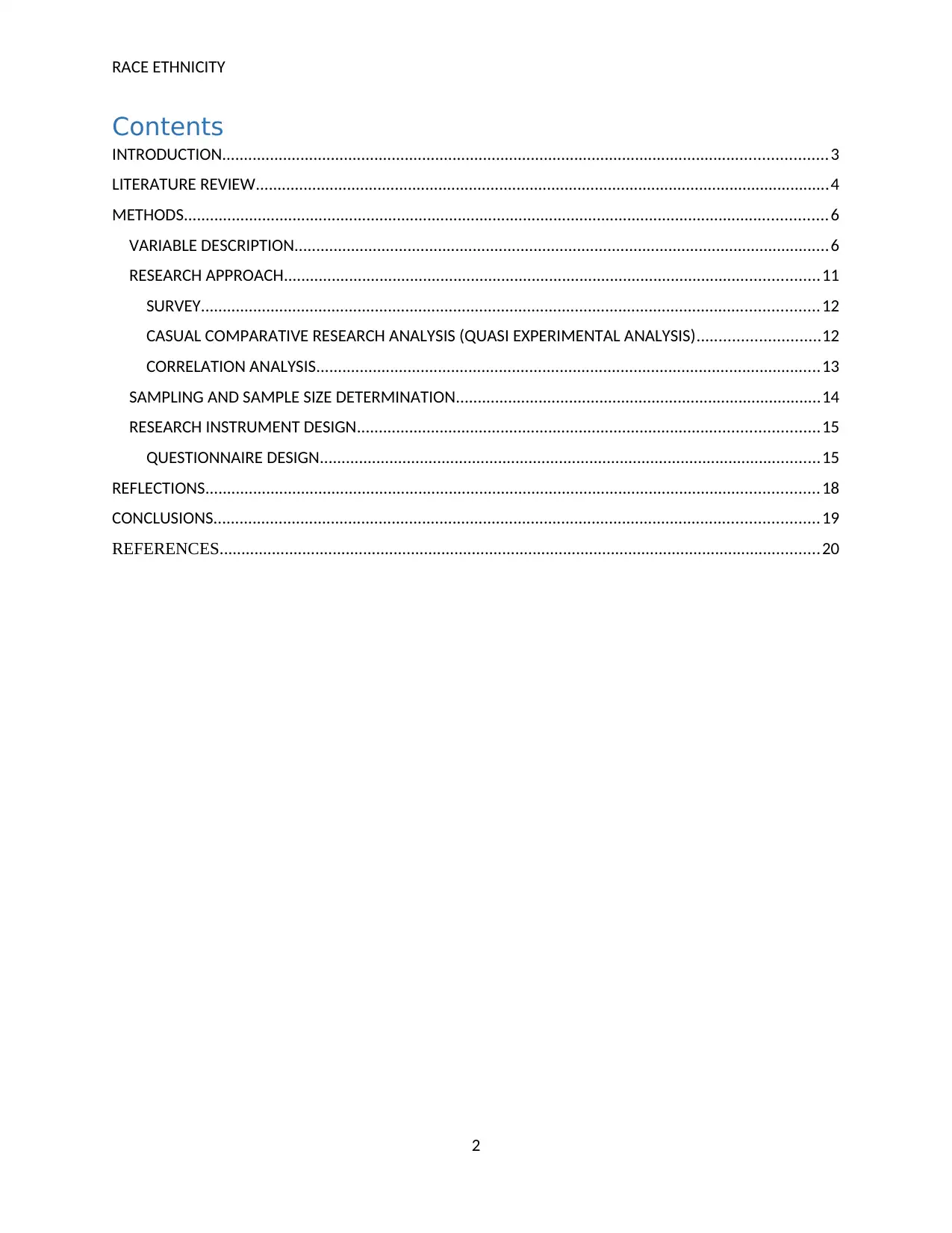
RACE ETHNICITY
Contents
INTRODUCTION...........................................................................................................................................3
LITERATURE REVIEW....................................................................................................................................4
METHODS....................................................................................................................................................6
VARIABLE DESCRIPTION...........................................................................................................................6
RESEARCH APPROACH...........................................................................................................................11
SURVEY..............................................................................................................................................12
CASUAL COMPARATIVE RESEARCH ANALYSIS (QUASI EXPERIMENTAL ANALYSIS)............................12
CORRELATION ANALYSIS....................................................................................................................13
SAMPLING AND SAMPLE SIZE DETERMINATION....................................................................................14
RESEARCH INSTRUMENT DESIGN..........................................................................................................15
QUESTIONNAIRE DESIGN...................................................................................................................15
REFLECTIONS.............................................................................................................................................18
CONCLUSIONS...........................................................................................................................................19
REFERENCES..........................................................................................................................................20
2
Contents
INTRODUCTION...........................................................................................................................................3
LITERATURE REVIEW....................................................................................................................................4
METHODS....................................................................................................................................................6
VARIABLE DESCRIPTION...........................................................................................................................6
RESEARCH APPROACH...........................................................................................................................11
SURVEY..............................................................................................................................................12
CASUAL COMPARATIVE RESEARCH ANALYSIS (QUASI EXPERIMENTAL ANALYSIS)............................12
CORRELATION ANALYSIS....................................................................................................................13
SAMPLING AND SAMPLE SIZE DETERMINATION....................................................................................14
RESEARCH INSTRUMENT DESIGN..........................................................................................................15
QUESTIONNAIRE DESIGN...................................................................................................................15
REFLECTIONS.............................................................................................................................................18
CONCLUSIONS...........................................................................................................................................19
REFERENCES..........................................................................................................................................20
2
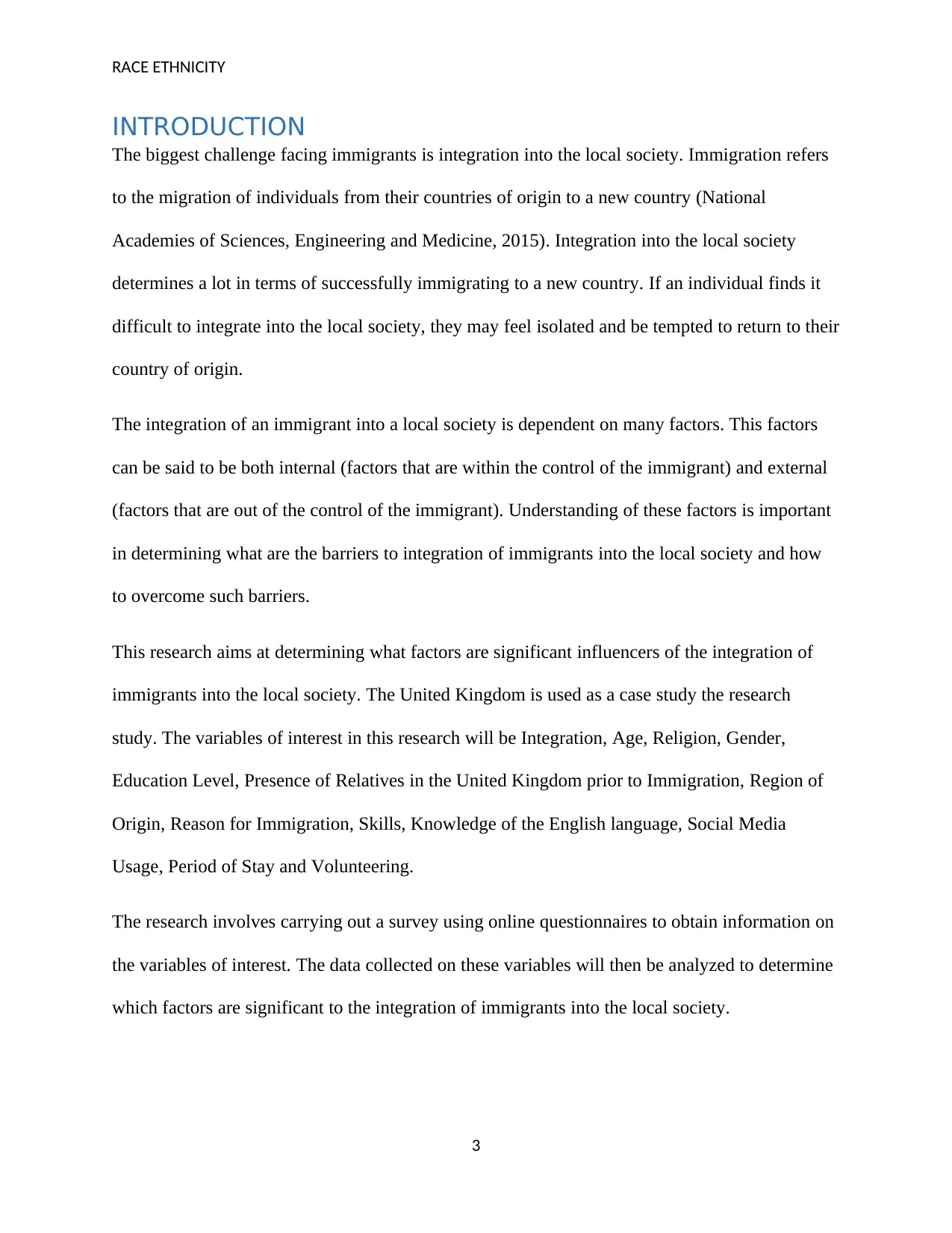
RACE ETHNICITY
INTRODUCTION
The biggest challenge facing immigrants is integration into the local society. Immigration refers
to the migration of individuals from their countries of origin to a new country (National
Academies of Sciences, Engineering and Medicine, 2015). Integration into the local society
determines a lot in terms of successfully immigrating to a new country. If an individual finds it
difficult to integrate into the local society, they may feel isolated and be tempted to return to their
country of origin.
The integration of an immigrant into a local society is dependent on many factors. This factors
can be said to be both internal (factors that are within the control of the immigrant) and external
(factors that are out of the control of the immigrant). Understanding of these factors is important
in determining what are the barriers to integration of immigrants into the local society and how
to overcome such barriers.
This research aims at determining what factors are significant influencers of the integration of
immigrants into the local society. The United Kingdom is used as a case study the research
study. The variables of interest in this research will be Integration, Age, Religion, Gender,
Education Level, Presence of Relatives in the United Kingdom prior to Immigration, Region of
Origin, Reason for Immigration, Skills, Knowledge of the English language, Social Media
Usage, Period of Stay and Volunteering.
The research involves carrying out a survey using online questionnaires to obtain information on
the variables of interest. The data collected on these variables will then be analyzed to determine
which factors are significant to the integration of immigrants into the local society.
3
INTRODUCTION
The biggest challenge facing immigrants is integration into the local society. Immigration refers
to the migration of individuals from their countries of origin to a new country (National
Academies of Sciences, Engineering and Medicine, 2015). Integration into the local society
determines a lot in terms of successfully immigrating to a new country. If an individual finds it
difficult to integrate into the local society, they may feel isolated and be tempted to return to their
country of origin.
The integration of an immigrant into a local society is dependent on many factors. This factors
can be said to be both internal (factors that are within the control of the immigrant) and external
(factors that are out of the control of the immigrant). Understanding of these factors is important
in determining what are the barriers to integration of immigrants into the local society and how
to overcome such barriers.
This research aims at determining what factors are significant influencers of the integration of
immigrants into the local society. The United Kingdom is used as a case study the research
study. The variables of interest in this research will be Integration, Age, Religion, Gender,
Education Level, Presence of Relatives in the United Kingdom prior to Immigration, Region of
Origin, Reason for Immigration, Skills, Knowledge of the English language, Social Media
Usage, Period of Stay and Volunteering.
The research involves carrying out a survey using online questionnaires to obtain information on
the variables of interest. The data collected on these variables will then be analyzed to determine
which factors are significant to the integration of immigrants into the local society.
3
⊘ This is a preview!⊘
Do you want full access?
Subscribe today to unlock all pages.

Trusted by 1+ million students worldwide
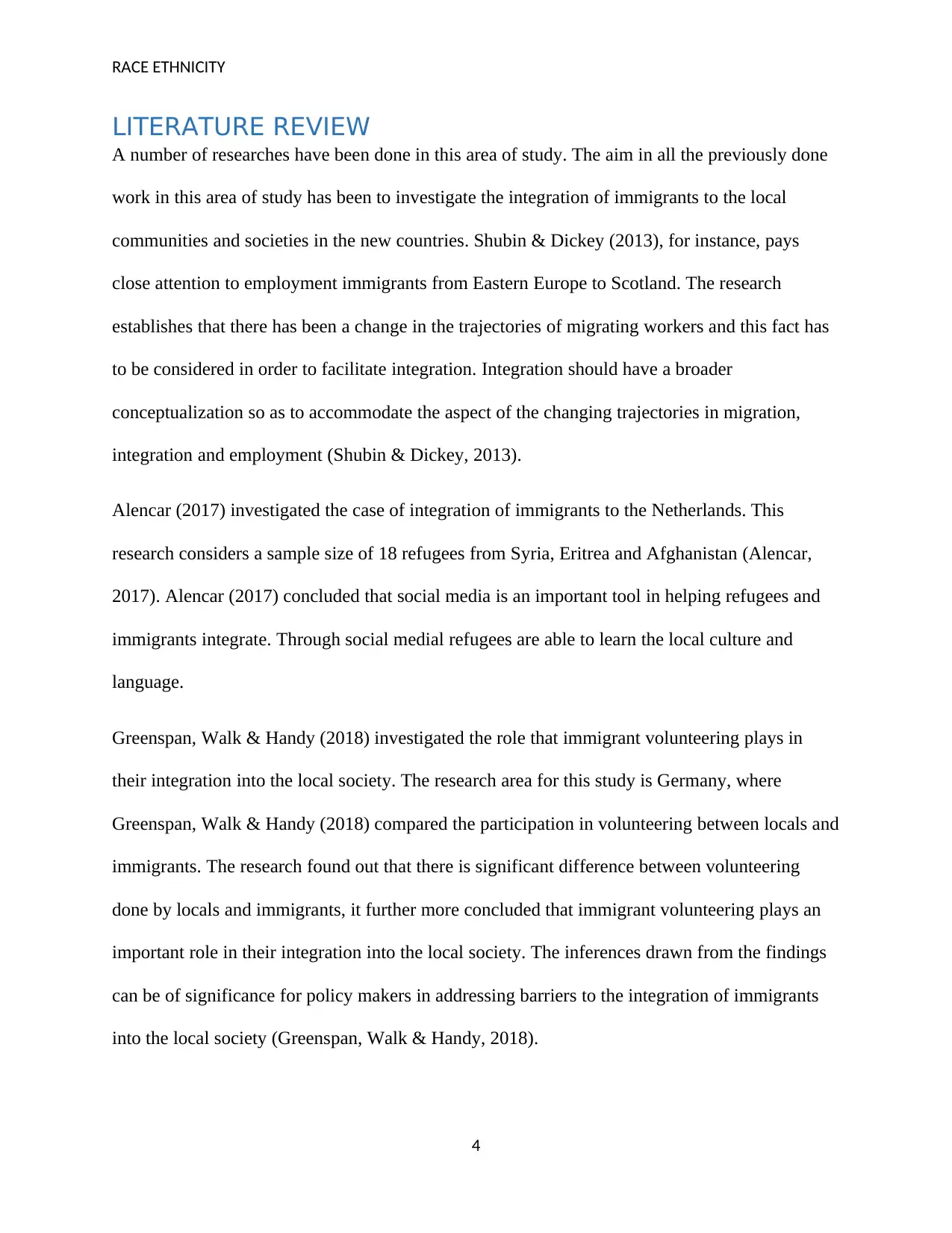
RACE ETHNICITY
LITERATURE REVIEW
A number of researches have been done in this area of study. The aim in all the previously done
work in this area of study has been to investigate the integration of immigrants to the local
communities and societies in the new countries. Shubin & Dickey (2013), for instance, pays
close attention to employment immigrants from Eastern Europe to Scotland. The research
establishes that there has been a change in the trajectories of migrating workers and this fact has
to be considered in order to facilitate integration. Integration should have a broader
conceptualization so as to accommodate the aspect of the changing trajectories in migration,
integration and employment (Shubin & Dickey, 2013).
Alencar (2017) investigated the case of integration of immigrants to the Netherlands. This
research considers a sample size of 18 refugees from Syria, Eritrea and Afghanistan (Alencar,
2017). Alencar (2017) concluded that social media is an important tool in helping refugees and
immigrants integrate. Through social medial refugees are able to learn the local culture and
language.
Greenspan, Walk & Handy (2018) investigated the role that immigrant volunteering plays in
their integration into the local society. The research area for this study is Germany, where
Greenspan, Walk & Handy (2018) compared the participation in volunteering between locals and
immigrants. The research found out that there is significant difference between volunteering
done by locals and immigrants, it further more concluded that immigrant volunteering plays an
important role in their integration into the local society. The inferences drawn from the findings
can be of significance for policy makers in addressing barriers to the integration of immigrants
into the local society (Greenspan, Walk & Handy, 2018).
4
LITERATURE REVIEW
A number of researches have been done in this area of study. The aim in all the previously done
work in this area of study has been to investigate the integration of immigrants to the local
communities and societies in the new countries. Shubin & Dickey (2013), for instance, pays
close attention to employment immigrants from Eastern Europe to Scotland. The research
establishes that there has been a change in the trajectories of migrating workers and this fact has
to be considered in order to facilitate integration. Integration should have a broader
conceptualization so as to accommodate the aspect of the changing trajectories in migration,
integration and employment (Shubin & Dickey, 2013).
Alencar (2017) investigated the case of integration of immigrants to the Netherlands. This
research considers a sample size of 18 refugees from Syria, Eritrea and Afghanistan (Alencar,
2017). Alencar (2017) concluded that social media is an important tool in helping refugees and
immigrants integrate. Through social medial refugees are able to learn the local culture and
language.
Greenspan, Walk & Handy (2018) investigated the role that immigrant volunteering plays in
their integration into the local society. The research area for this study is Germany, where
Greenspan, Walk & Handy (2018) compared the participation in volunteering between locals and
immigrants. The research found out that there is significant difference between volunteering
done by locals and immigrants, it further more concluded that immigrant volunteering plays an
important role in their integration into the local society. The inferences drawn from the findings
can be of significance for policy makers in addressing barriers to the integration of immigrants
into the local society (Greenspan, Walk & Handy, 2018).
4
Paraphrase This Document
Need a fresh take? Get an instant paraphrase of this document with our AI Paraphraser
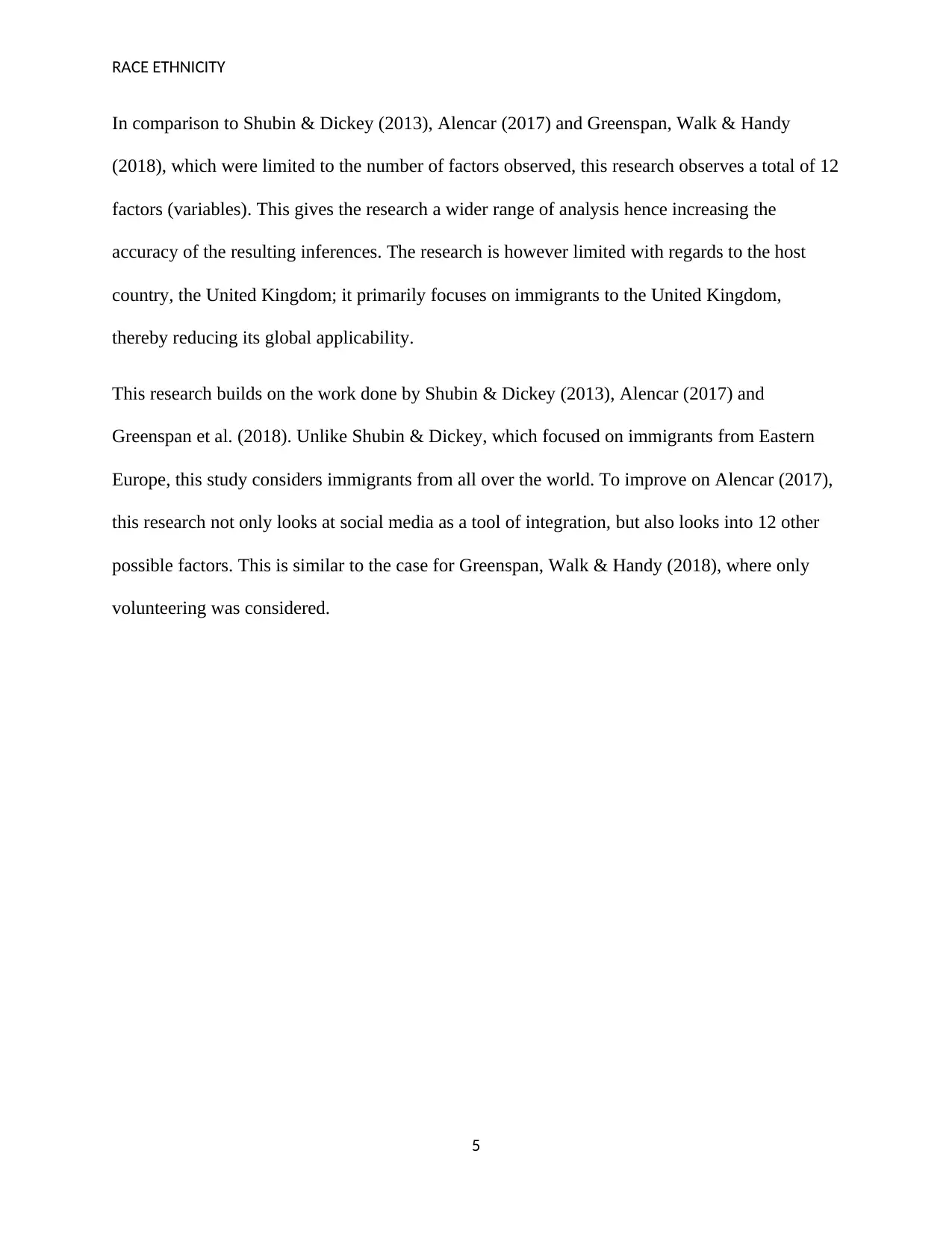
RACE ETHNICITY
In comparison to Shubin & Dickey (2013), Alencar (2017) and Greenspan, Walk & Handy
(2018), which were limited to the number of factors observed, this research observes a total of 12
factors (variables). This gives the research a wider range of analysis hence increasing the
accuracy of the resulting inferences. The research is however limited with regards to the host
country, the United Kingdom; it primarily focuses on immigrants to the United Kingdom,
thereby reducing its global applicability.
This research builds on the work done by Shubin & Dickey (2013), Alencar (2017) and
Greenspan et al. (2018). Unlike Shubin & Dickey, which focused on immigrants from Eastern
Europe, this study considers immigrants from all over the world. To improve on Alencar (2017),
this research not only looks at social media as a tool of integration, but also looks into 12 other
possible factors. This is similar to the case for Greenspan, Walk & Handy (2018), where only
volunteering was considered.
5
In comparison to Shubin & Dickey (2013), Alencar (2017) and Greenspan, Walk & Handy
(2018), which were limited to the number of factors observed, this research observes a total of 12
factors (variables). This gives the research a wider range of analysis hence increasing the
accuracy of the resulting inferences. The research is however limited with regards to the host
country, the United Kingdom; it primarily focuses on immigrants to the United Kingdom,
thereby reducing its global applicability.
This research builds on the work done by Shubin & Dickey (2013), Alencar (2017) and
Greenspan et al. (2018). Unlike Shubin & Dickey, which focused on immigrants from Eastern
Europe, this study considers immigrants from all over the world. To improve on Alencar (2017),
this research not only looks at social media as a tool of integration, but also looks into 12 other
possible factors. This is similar to the case for Greenspan, Walk & Handy (2018), where only
volunteering was considered.
5
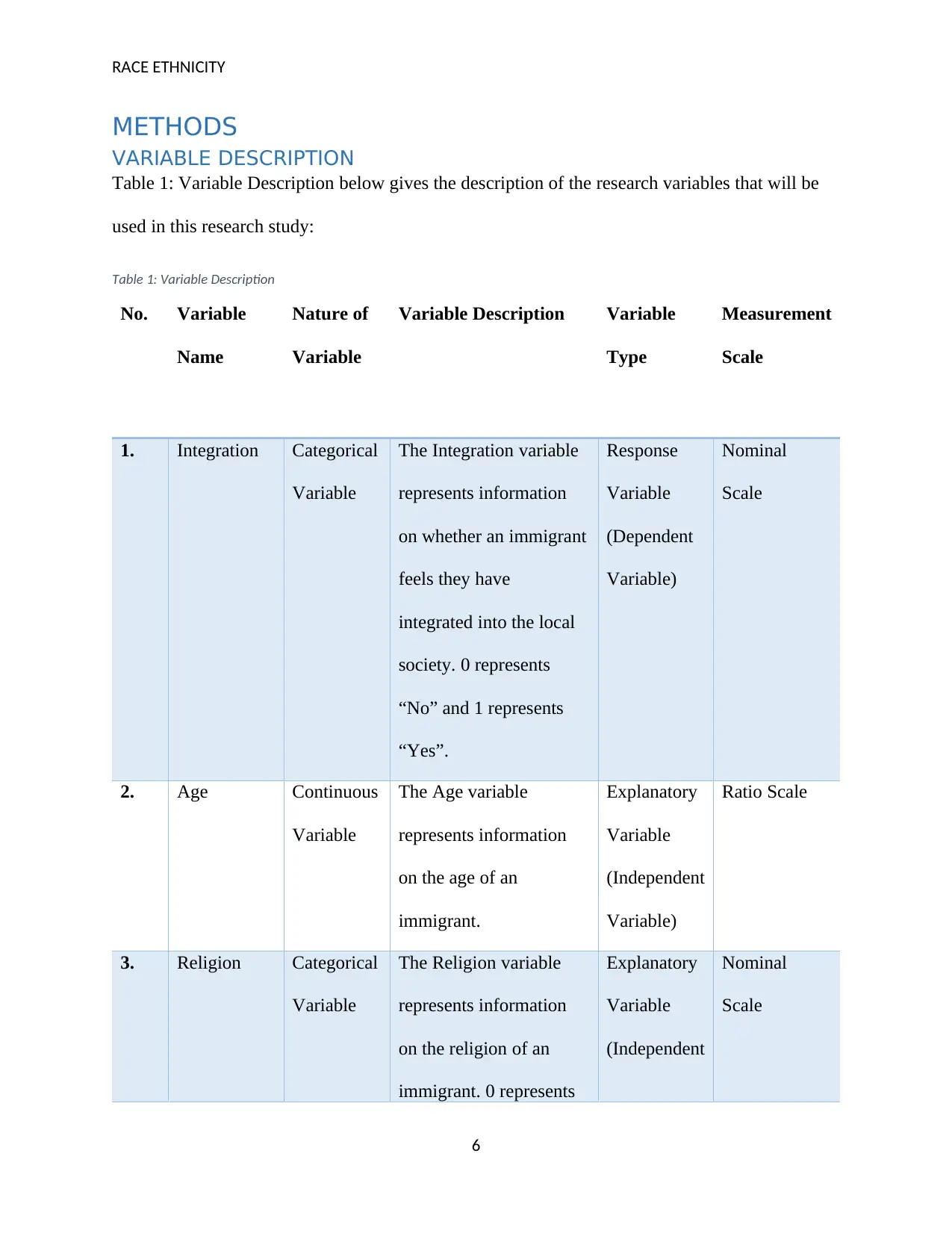
RACE ETHNICITY
METHODS
VARIABLE DESCRIPTION
Table 1: Variable Description below gives the description of the research variables that will be
used in this research study:
Table 1: Variable Description
No. Variable
Name
Nature of
Variable
Variable Description Variable
Type
Measurement
Scale
1. Integration Categorical
Variable
The Integration variable
represents information
on whether an immigrant
feels they have
integrated into the local
society. 0 represents
“No” and 1 represents
“Yes”.
Response
Variable
(Dependent
Variable)
Nominal
Scale
2. Age Continuous
Variable
The Age variable
represents information
on the age of an
immigrant.
Explanatory
Variable
(Independent
Variable)
Ratio Scale
3. Religion Categorical
Variable
The Religion variable
represents information
on the religion of an
immigrant. 0 represents
Explanatory
Variable
(Independent
Nominal
Scale
6
METHODS
VARIABLE DESCRIPTION
Table 1: Variable Description below gives the description of the research variables that will be
used in this research study:
Table 1: Variable Description
No. Variable
Name
Nature of
Variable
Variable Description Variable
Type
Measurement
Scale
1. Integration Categorical
Variable
The Integration variable
represents information
on whether an immigrant
feels they have
integrated into the local
society. 0 represents
“No” and 1 represents
“Yes”.
Response
Variable
(Dependent
Variable)
Nominal
Scale
2. Age Continuous
Variable
The Age variable
represents information
on the age of an
immigrant.
Explanatory
Variable
(Independent
Variable)
Ratio Scale
3. Religion Categorical
Variable
The Religion variable
represents information
on the religion of an
immigrant. 0 represents
Explanatory
Variable
(Independent
Nominal
Scale
6
⊘ This is a preview!⊘
Do you want full access?
Subscribe today to unlock all pages.

Trusted by 1+ million students worldwide
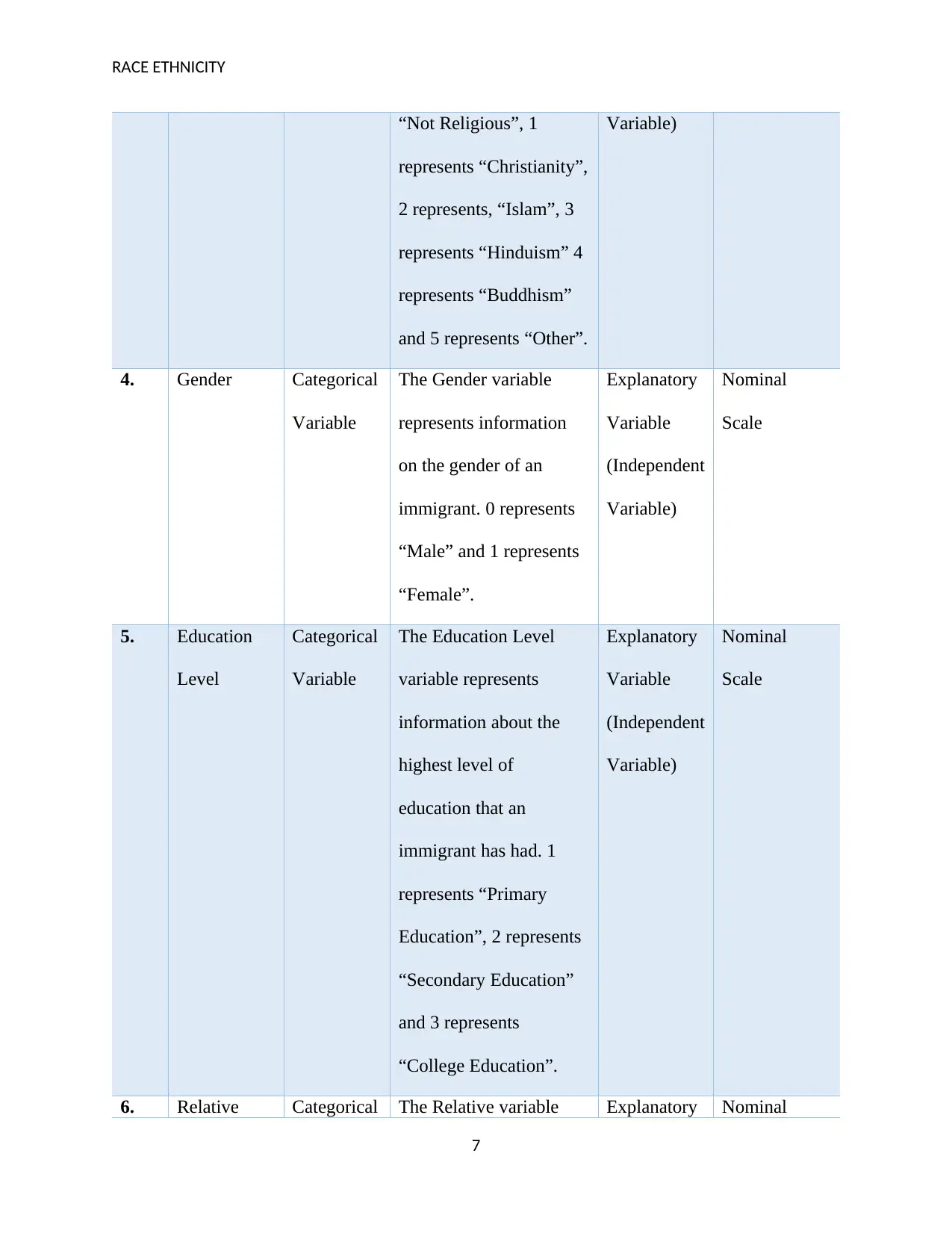
RACE ETHNICITY
“Not Religious”, 1
represents “Christianity”,
2 represents, “Islam”, 3
represents “Hinduism” 4
represents “Buddhism”
and 5 represents “Other”.
Variable)
4. Gender Categorical
Variable
The Gender variable
represents information
on the gender of an
immigrant. 0 represents
“Male” and 1 represents
“Female”.
Explanatory
Variable
(Independent
Variable)
Nominal
Scale
5. Education
Level
Categorical
Variable
The Education Level
variable represents
information about the
highest level of
education that an
immigrant has had. 1
represents “Primary
Education”, 2 represents
“Secondary Education”
and 3 represents
“College Education”.
Explanatory
Variable
(Independent
Variable)
Nominal
Scale
6. Relative Categorical The Relative variable Explanatory Nominal
7
“Not Religious”, 1
represents “Christianity”,
2 represents, “Islam”, 3
represents “Hinduism” 4
represents “Buddhism”
and 5 represents “Other”.
Variable)
4. Gender Categorical
Variable
The Gender variable
represents information
on the gender of an
immigrant. 0 represents
“Male” and 1 represents
“Female”.
Explanatory
Variable
(Independent
Variable)
Nominal
Scale
5. Education
Level
Categorical
Variable
The Education Level
variable represents
information about the
highest level of
education that an
immigrant has had. 1
represents “Primary
Education”, 2 represents
“Secondary Education”
and 3 represents
“College Education”.
Explanatory
Variable
(Independent
Variable)
Nominal
Scale
6. Relative Categorical The Relative variable Explanatory Nominal
7
Paraphrase This Document
Need a fresh take? Get an instant paraphrase of this document with our AI Paraphraser
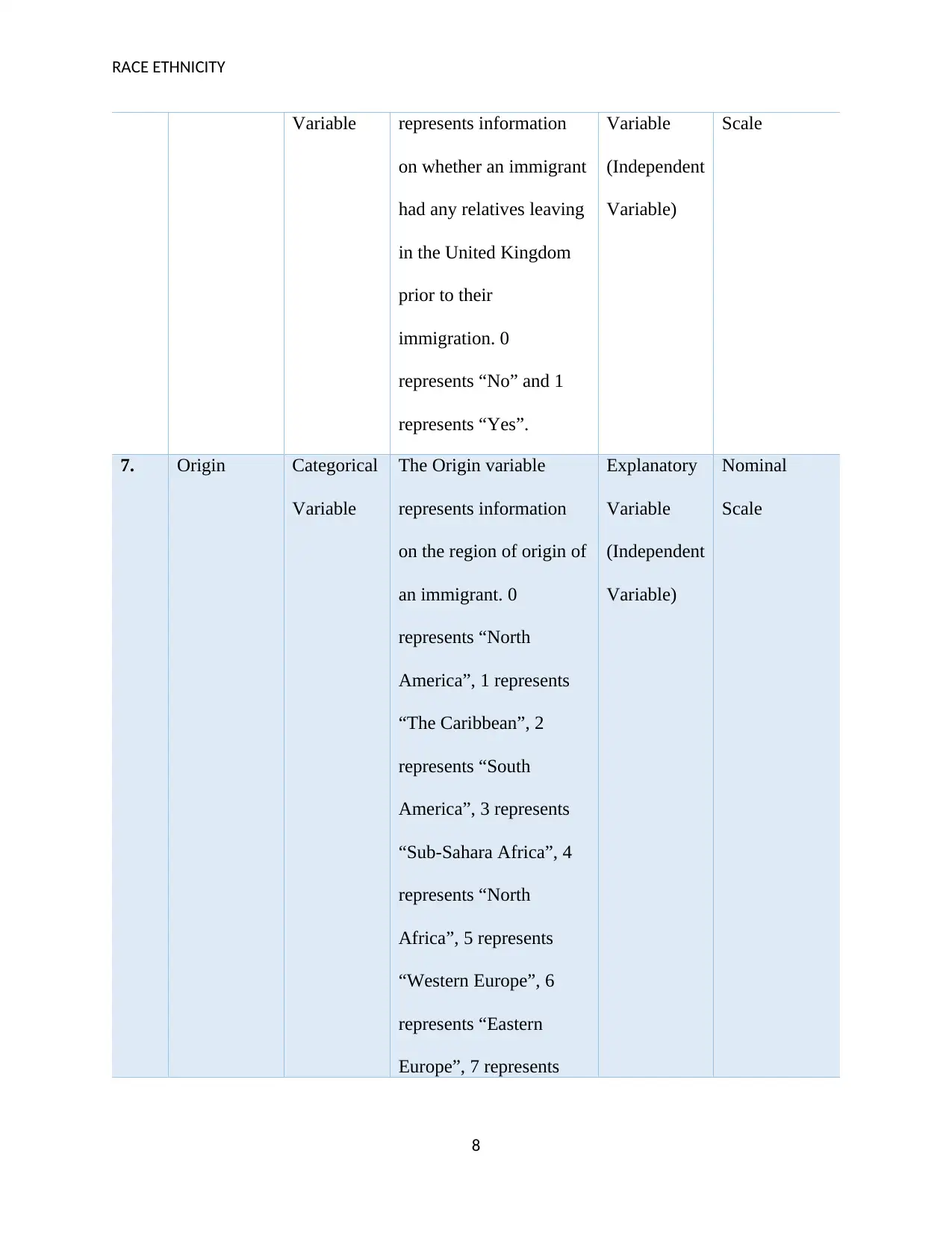
RACE ETHNICITY
Variable represents information
on whether an immigrant
had any relatives leaving
in the United Kingdom
prior to their
immigration. 0
represents “No” and 1
represents “Yes”.
Variable
(Independent
Variable)
Scale
7. Origin Categorical
Variable
The Origin variable
represents information
on the region of origin of
an immigrant. 0
represents “North
America”, 1 represents
“The Caribbean”, 2
represents “South
America”, 3 represents
“Sub-Sahara Africa”, 4
represents “North
Africa”, 5 represents
“Western Europe”, 6
represents “Eastern
Europe”, 7 represents
Explanatory
Variable
(Independent
Variable)
Nominal
Scale
8
Variable represents information
on whether an immigrant
had any relatives leaving
in the United Kingdom
prior to their
immigration. 0
represents “No” and 1
represents “Yes”.
Variable
(Independent
Variable)
Scale
7. Origin Categorical
Variable
The Origin variable
represents information
on the region of origin of
an immigrant. 0
represents “North
America”, 1 represents
“The Caribbean”, 2
represents “South
America”, 3 represents
“Sub-Sahara Africa”, 4
represents “North
Africa”, 5 represents
“Western Europe”, 6
represents “Eastern
Europe”, 7 represents
Explanatory
Variable
(Independent
Variable)
Nominal
Scale
8
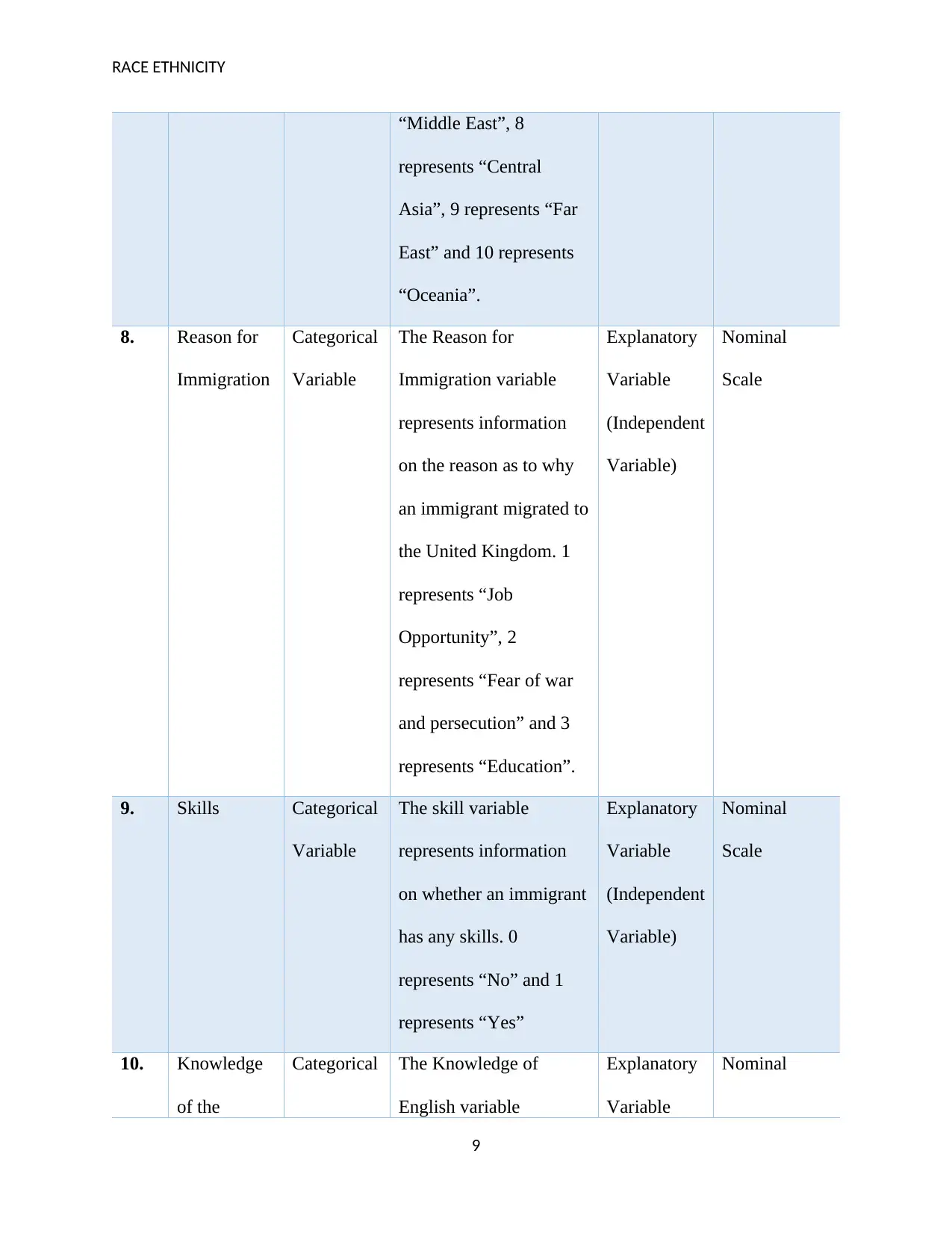
RACE ETHNICITY
“Middle East”, 8
represents “Central
Asia”, 9 represents “Far
East” and 10 represents
“Oceania”.
8. Reason for
Immigration
Categorical
Variable
The Reason for
Immigration variable
represents information
on the reason as to why
an immigrant migrated to
the United Kingdom. 1
represents “Job
Opportunity”, 2
represents “Fear of war
and persecution” and 3
represents “Education”.
Explanatory
Variable
(Independent
Variable)
Nominal
Scale
9. Skills Categorical
Variable
The skill variable
represents information
on whether an immigrant
has any skills. 0
represents “No” and 1
represents “Yes”
Explanatory
Variable
(Independent
Variable)
Nominal
Scale
10. Knowledge
of the
Categorical The Knowledge of
English variable
Explanatory
Variable
Nominal
9
“Middle East”, 8
represents “Central
Asia”, 9 represents “Far
East” and 10 represents
“Oceania”.
8. Reason for
Immigration
Categorical
Variable
The Reason for
Immigration variable
represents information
on the reason as to why
an immigrant migrated to
the United Kingdom. 1
represents “Job
Opportunity”, 2
represents “Fear of war
and persecution” and 3
represents “Education”.
Explanatory
Variable
(Independent
Variable)
Nominal
Scale
9. Skills Categorical
Variable
The skill variable
represents information
on whether an immigrant
has any skills. 0
represents “No” and 1
represents “Yes”
Explanatory
Variable
(Independent
Variable)
Nominal
Scale
10. Knowledge
of the
Categorical The Knowledge of
English variable
Explanatory
Variable
Nominal
9
⊘ This is a preview!⊘
Do you want full access?
Subscribe today to unlock all pages.

Trusted by 1+ million students worldwide
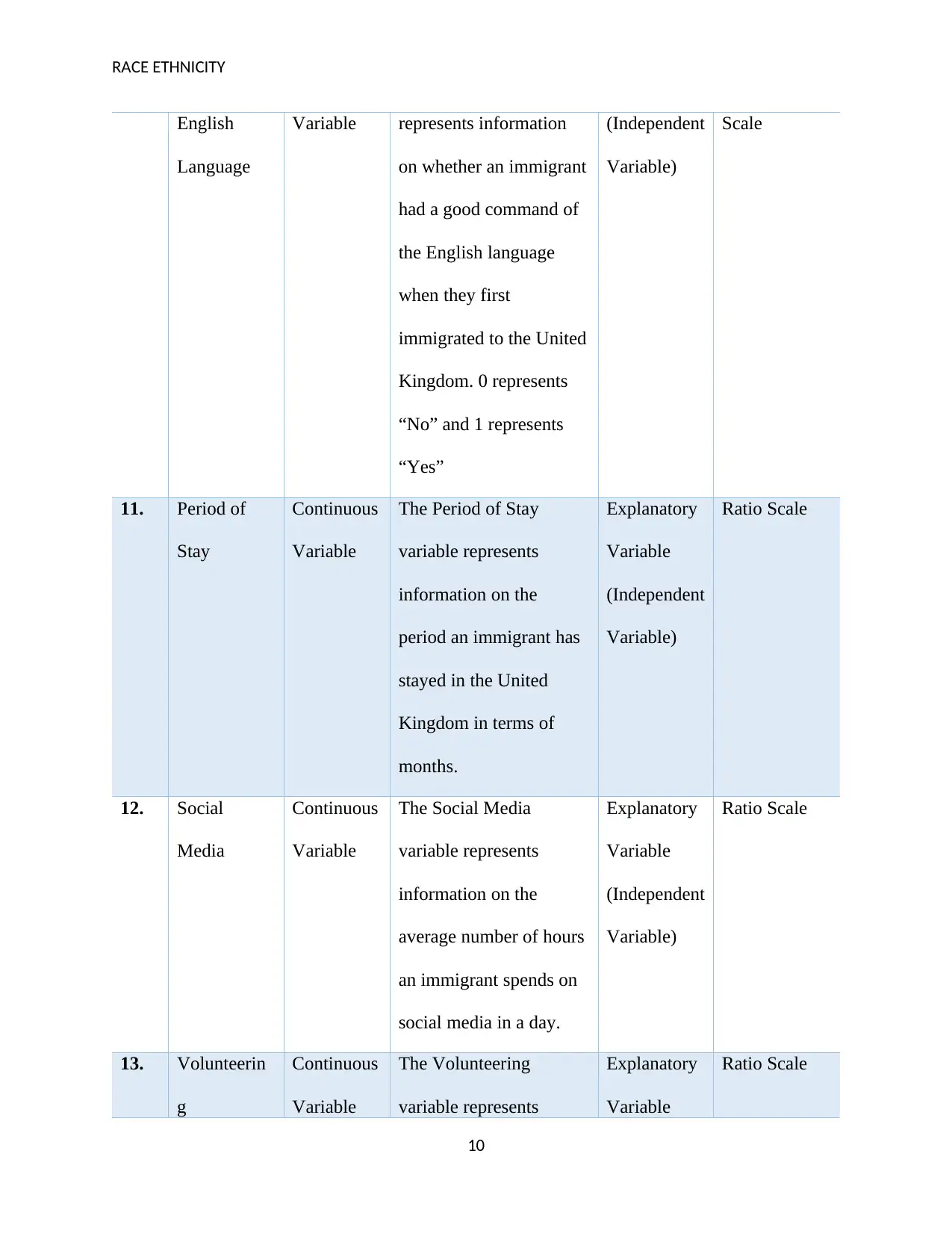
RACE ETHNICITY
English
Language
Variable represents information
on whether an immigrant
had a good command of
the English language
when they first
immigrated to the United
Kingdom. 0 represents
“No” and 1 represents
“Yes”
(Independent
Variable)
Scale
11. Period of
Stay
Continuous
Variable
The Period of Stay
variable represents
information on the
period an immigrant has
stayed in the United
Kingdom in terms of
months.
Explanatory
Variable
(Independent
Variable)
Ratio Scale
12. Social
Media
Continuous
Variable
The Social Media
variable represents
information on the
average number of hours
an immigrant spends on
social media in a day.
Explanatory
Variable
(Independent
Variable)
Ratio Scale
13. Volunteerin
g
Continuous
Variable
The Volunteering
variable represents
Explanatory
Variable
Ratio Scale
10
English
Language
Variable represents information
on whether an immigrant
had a good command of
the English language
when they first
immigrated to the United
Kingdom. 0 represents
“No” and 1 represents
“Yes”
(Independent
Variable)
Scale
11. Period of
Stay
Continuous
Variable
The Period of Stay
variable represents
information on the
period an immigrant has
stayed in the United
Kingdom in terms of
months.
Explanatory
Variable
(Independent
Variable)
Ratio Scale
12. Social
Media
Continuous
Variable
The Social Media
variable represents
information on the
average number of hours
an immigrant spends on
social media in a day.
Explanatory
Variable
(Independent
Variable)
Ratio Scale
13. Volunteerin
g
Continuous
Variable
The Volunteering
variable represents
Explanatory
Variable
Ratio Scale
10
Paraphrase This Document
Need a fresh take? Get an instant paraphrase of this document with our AI Paraphraser
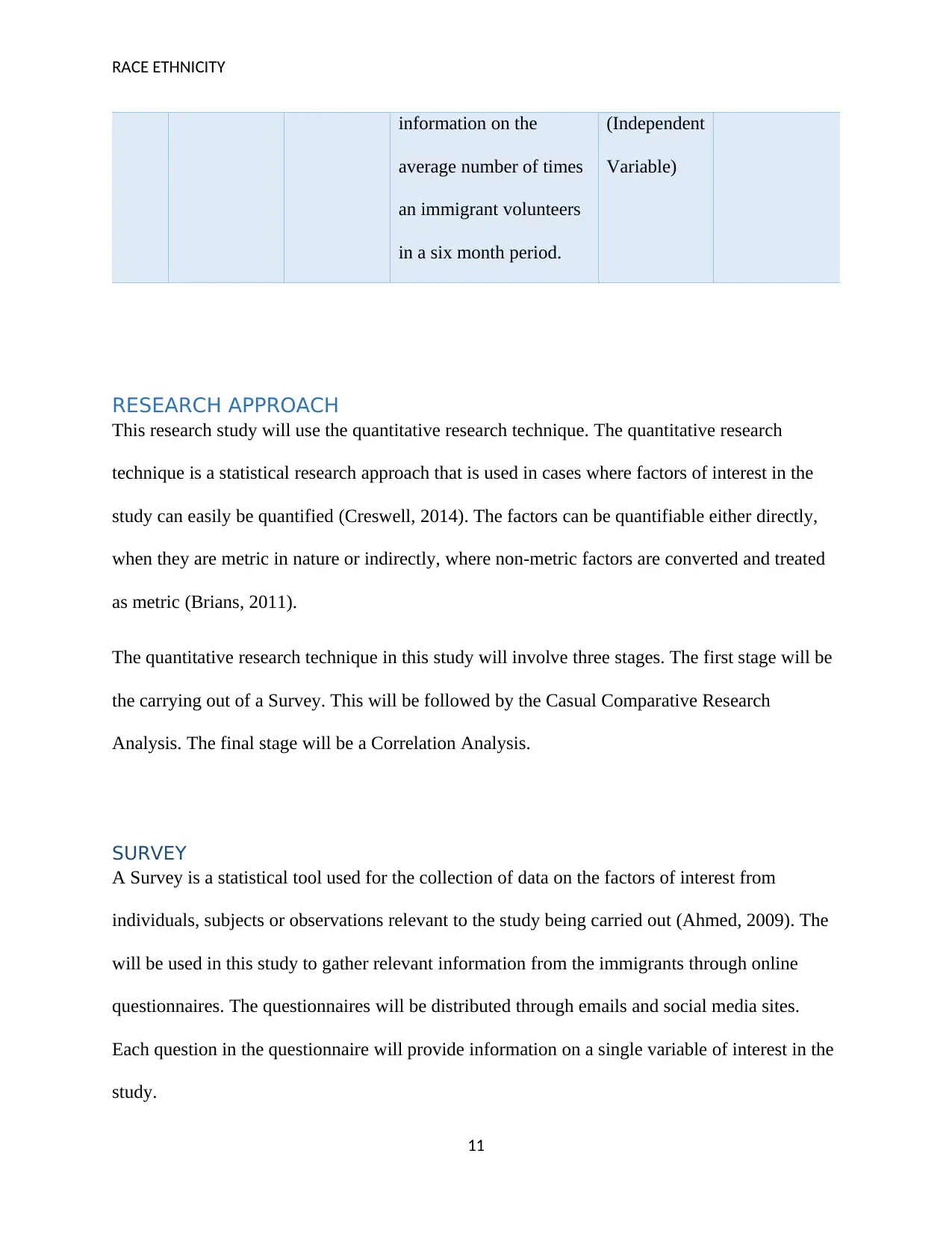
RACE ETHNICITY
information on the
average number of times
an immigrant volunteers
in a six month period.
(Independent
Variable)
RESEARCH APPROACH
This research study will use the quantitative research technique. The quantitative research
technique is a statistical research approach that is used in cases where factors of interest in the
study can easily be quantified (Creswell, 2014). The factors can be quantifiable either directly,
when they are metric in nature or indirectly, where non-metric factors are converted and treated
as metric (Brians, 2011).
The quantitative research technique in this study will involve three stages. The first stage will be
the carrying out of a Survey. This will be followed by the Casual Comparative Research
Analysis. The final stage will be a Correlation Analysis.
SURVEY
A Survey is a statistical tool used for the collection of data on the factors of interest from
individuals, subjects or observations relevant to the study being carried out (Ahmed, 2009). The
will be used in this study to gather relevant information from the immigrants through online
questionnaires. The questionnaires will be distributed through emails and social media sites.
Each question in the questionnaire will provide information on a single variable of interest in the
study.
11
information on the
average number of times
an immigrant volunteers
in a six month period.
(Independent
Variable)
RESEARCH APPROACH
This research study will use the quantitative research technique. The quantitative research
technique is a statistical research approach that is used in cases where factors of interest in the
study can easily be quantified (Creswell, 2014). The factors can be quantifiable either directly,
when they are metric in nature or indirectly, where non-metric factors are converted and treated
as metric (Brians, 2011).
The quantitative research technique in this study will involve three stages. The first stage will be
the carrying out of a Survey. This will be followed by the Casual Comparative Research
Analysis. The final stage will be a Correlation Analysis.
SURVEY
A Survey is a statistical tool used for the collection of data on the factors of interest from
individuals, subjects or observations relevant to the study being carried out (Ahmed, 2009). The
will be used in this study to gather relevant information from the immigrants through online
questionnaires. The questionnaires will be distributed through emails and social media sites.
Each question in the questionnaire will provide information on a single variable of interest in the
study.
11
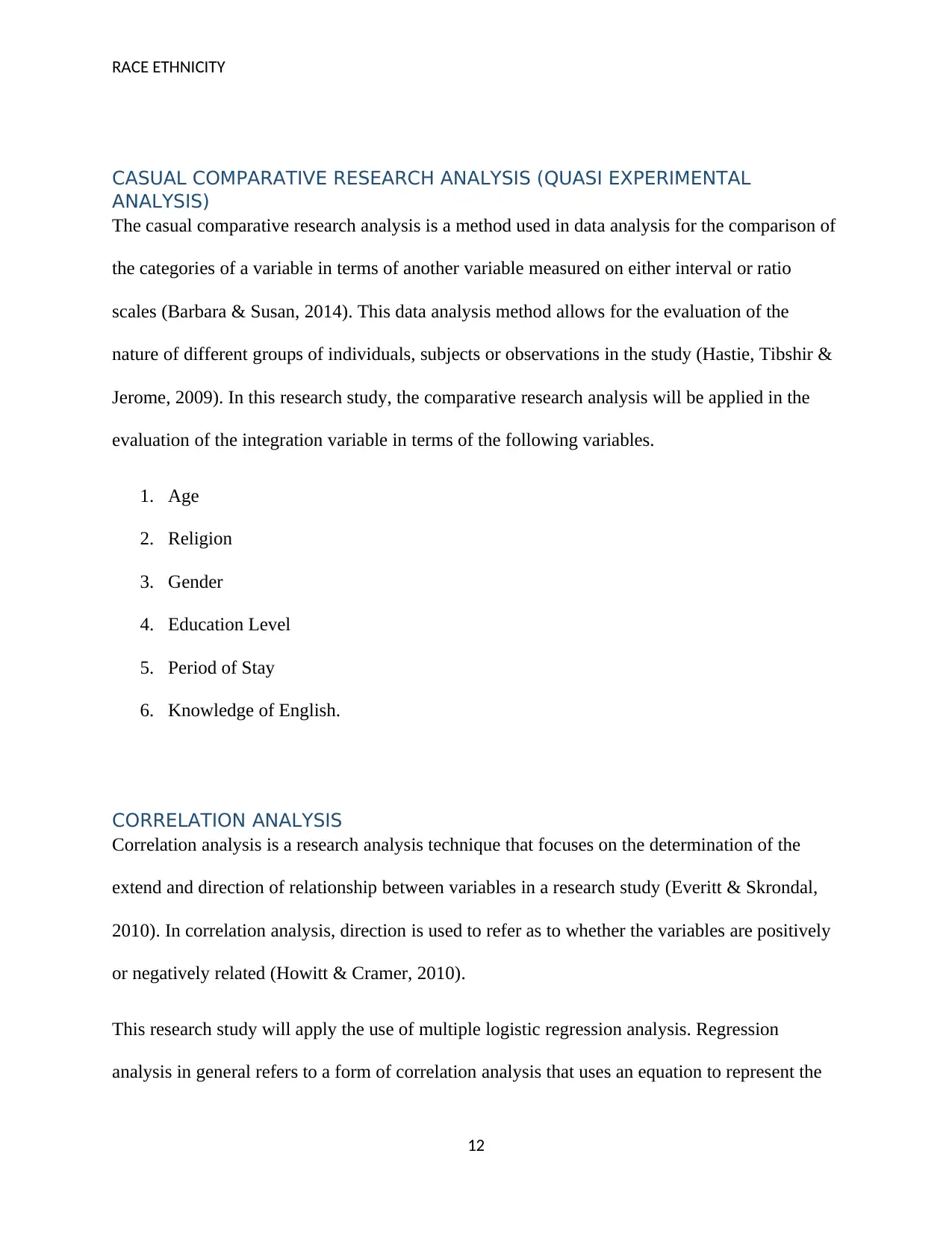
RACE ETHNICITY
CASUAL COMPARATIVE RESEARCH ANALYSIS (QUASI EXPERIMENTAL
ANALYSIS)
The casual comparative research analysis is a method used in data analysis for the comparison of
the categories of a variable in terms of another variable measured on either interval or ratio
scales (Barbara & Susan, 2014). This data analysis method allows for the evaluation of the
nature of different groups of individuals, subjects or observations in the study (Hastie, Tibshir &
Jerome, 2009). In this research study, the comparative research analysis will be applied in the
evaluation of the integration variable in terms of the following variables.
1. Age
2. Religion
3. Gender
4. Education Level
5. Period of Stay
6. Knowledge of English.
CORRELATION ANALYSIS
Correlation analysis is a research analysis technique that focuses on the determination of the
extend and direction of relationship between variables in a research study (Everitt & Skrondal,
2010). In correlation analysis, direction is used to refer as to whether the variables are positively
or negatively related (Howitt & Cramer, 2010).
This research study will apply the use of multiple logistic regression analysis. Regression
analysis in general refers to a form of correlation analysis that uses an equation to represent the
12
CASUAL COMPARATIVE RESEARCH ANALYSIS (QUASI EXPERIMENTAL
ANALYSIS)
The casual comparative research analysis is a method used in data analysis for the comparison of
the categories of a variable in terms of another variable measured on either interval or ratio
scales (Barbara & Susan, 2014). This data analysis method allows for the evaluation of the
nature of different groups of individuals, subjects or observations in the study (Hastie, Tibshir &
Jerome, 2009). In this research study, the comparative research analysis will be applied in the
evaluation of the integration variable in terms of the following variables.
1. Age
2. Religion
3. Gender
4. Education Level
5. Period of Stay
6. Knowledge of English.
CORRELATION ANALYSIS
Correlation analysis is a research analysis technique that focuses on the determination of the
extend and direction of relationship between variables in a research study (Everitt & Skrondal,
2010). In correlation analysis, direction is used to refer as to whether the variables are positively
or negatively related (Howitt & Cramer, 2010).
This research study will apply the use of multiple logistic regression analysis. Regression
analysis in general refers to a form of correlation analysis that uses an equation to represent the
12
⊘ This is a preview!⊘
Do you want full access?
Subscribe today to unlock all pages.

Trusted by 1+ million students worldwide
1 out of 21
Related Documents
Your All-in-One AI-Powered Toolkit for Academic Success.
+13062052269
info@desklib.com
Available 24*7 on WhatsApp / Email
![[object Object]](/_next/static/media/star-bottom.7253800d.svg)
Unlock your academic potential
Copyright © 2020–2025 A2Z Services. All Rights Reserved. Developed and managed by ZUCOL.





